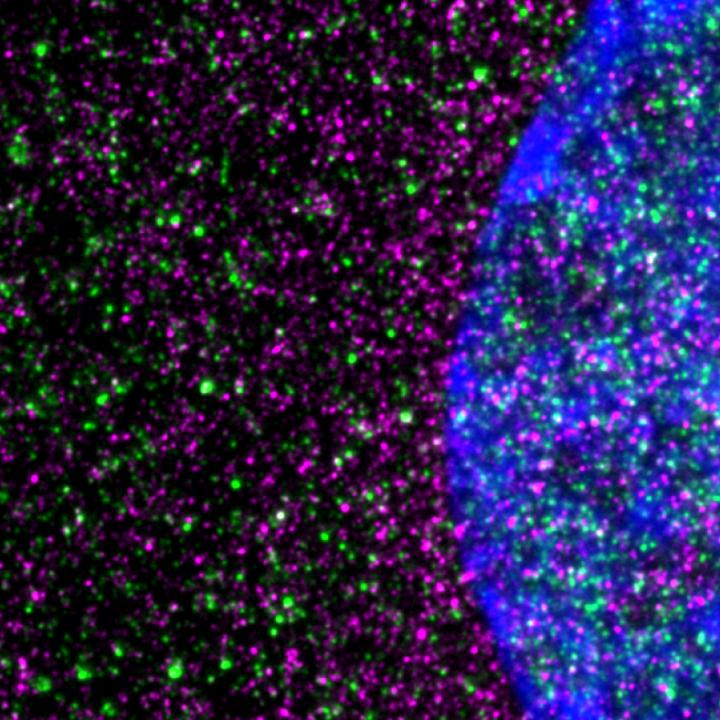New study shows that mutant huntingtin protein slows ribosomes

Credit: Image by Nicolai Urban of Max Planck Institute for Neuroscience in Jupiter, Florida.
JUPITER, FL — In 1993, scientists discovered that a single mutated gene, HTT, caused Huntington’s disease, raising high hopes for a quick cure. Yet today, there’s still no approved treatment.
One difficulty has been a limited understanding of how the mutant huntingtin protein sets off brain cell death, says neuroscientist Srinivasa Subramaniam, PhD, of Scripps Research, Florida. In a new study published in Nature Communications on Friday, Subramaniam’s group has shown that the mutated huntingtin protein slows brain cells’ protein-building machines, called ribosomes.
“The ribosome has to keep moving along to build the proteins, but in Huntington’s disease, the ribosome is slowed,” Subramaniam says. “The difference may be two, three, four-fold slower. That makes all the difference.”
Cells contain millions of ribosomes each, all whirring along and using genetic information to assemble amino acids and make proteins. Impairment of their activity is ultimately devastating for the cell, Subramaniam says.
“It’s not possible for the cell to stay alive without protein production,” he says.
The team’s discoveries were made possible by recent advancements in gene translation tracking technologies, Subramaniam says. The results suggest a new route for development of therapeutics, and have implications for multiple neurodegenerative diseases in which ribosome stalling appears to play a role.
Huntington’s disease affects about 10 people per 100,000 in the United States. It is caused by an excessive number of genetic repeats of three DNA building blocks. Known by the letters CAG, short for cytosine, adenine and guanine, 40 or more of these repeats in the HTT gene causes the brain degenerative disease, which is ultimately fatal. The more repeats present, the earlier the onset of symptoms, which include behavioral disturbances, movement and balance difficulty, weakness and difficulty speaking and eating. The symptoms are caused by degeneration of brain tissue that begins in a region called the striatum, and then spreads. The striatum is the region deep in the center of the brain that controls voluntary movement and responds to social reward.
For their experiments, the scientists used striatal cells engineered to have three different degrees of CAG repeats in the HTT gene. They assessed the impact of the CAG repeats using a technology called Ribo-Seq, short for high-resolution global ribosome footprint profiling, plus mRNA-seq, a method that allows a snapshot of which genes are active, and which are not in a given cell at a given moment.
The scientists found that in the Huntington’s cells, translation of many, not all, proteins were slowed. To verify the finding, they blocked the cells’ ability to make mutant huntingtin protein, and found the speed of ribosome movement and protein synthesis increased. They also assessed how mutant huntingtin protein impacted translation of other genes, and ruled out the possibility that another ribosome-binding protein, Fmrp, might be causing the slowing effect.
Further experiments offered some clues as to how the mutant huntingtin protein interfered with the ribosomes’ work. They found it bound directly to ribosomal proteins and the ribosomal assembly, and not only affected speed of protein synthesis, but also of ribosomal density within the cell.
Many questions remain, Subramaniam says, but the advance offers a new direction for helping people with Huntington’s disease.
“The idea that the ribosome can stall before a CAG repeat is something people have predicted. We can show that it’s there,” Subramaniam says. “There’s a lot of additional work that needs to be done to figure out how the CAG repeat stalls the ribosome, and then perhaps we can make medications to counteract it.”
###
In addition to Subramaniam, the authors of the paper, “Mutant Huntingtin Stalls Ribosomes and Represses Protein Synthesis in a Cellular Model of Huntington Disease,” include Mehdi Eshraghi, Pabalu Karunadharma, Neelam Shahani, Nicole Galli, Manish Sharma, Uri Nimrod Ramírez-Jarquín, Katie Florescu, and Jennifer Hernandez of Scripps Research; Juliana Blin and Emiliano P Ricci of the RNA Metabolism in Immunity and Infection Lab, Laboratory of Biology and Cellular Modelling of Lyon, France; Audrey Michel of RiboMaps of Cork, Ireland; and Nicolai Urban of the Max Planck Neuroscience Institute in Jupiter, Florida.
Media Contact
Stacey DeLoye
[email protected]
Related Journal Article
http://dx.




